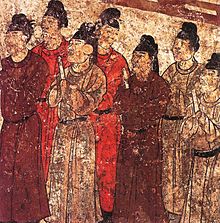
A eunuch (/ˈjuːnək/ YOO-nək)[1] is a man who has been castrated.[2] Throughout history, castration often served a specific social function.[3] In China, castration included removal of the penis as well as the testicles (see emasculation). Both organs were cut off with a knife at the same time.[4]
Eunuchs existed in China starting around 146 AD during the reign of Emperor Huan of Han,[5] and were common as civil servants by the time of the Qin dynasty.[6][7] From those ancient times until the Sui dynasty, castration was both a traditional punishment (one of the Five Punishments) and a means of gaining employment in the Imperial service. Certain eunuchs gained immense power that occasionally superseded that of even the Grand Secretaries such as the Ming dynasty official Zheng He. Self-castration was a common practice, although it was not always performed completely, which led to it being made illegal.
It is said that the justification for the employment of eunuchs as high-ranking civil servants was that, since they were incapable of having children, they would not be tempted to seize power and start a dynasty. In many cases, eunuchs were considered more reliable than the scholar-officials.[8] As a symbolic assignment of heavenly authority to the palace system, a constellation of stars was designated as the Emperor's, and, to the west of it, four stars were identified as his "eunuchs."[9]
The tension between eunuchs in the service of the emperor and virtuous Confucian officials is a familiar theme in Chinese history. In his History of Government, Samuel Finer points out that reality was not always that clear-cut. There were instances of very capable eunuchs who were valuable advisers to their emperor, and the resistance of the "virtuous" officials often stemmed from jealousy on their part. Ray Huang argues that in reality, eunuchs represented the personal will of the Emperor, while the officials represented the alternative political will of the bureaucracy. The clash between them would thus have been a clash of ideologies or political agenda.[10]
The number of eunuchs in Imperial employ fell to 470 by 1912, with the eunuch system being abolished on November 5, 1924.[5] The last Imperial eunuch, Sun Yaoting, died in December 1996.[11]
- ^ εὐνοῦχος. Liddell, Henry George; Scott, Robert; A Greek–English Lexicon at the Perseus Project.
- ^ "eunuch". dictionary.cambridge.org. Retrieved 25 February 2021.
- ^ "Eunuch". The New Oxford Dictionary of English. Oxford: Clarendon Press. 1998. p. 634. ISBN 978-0-19-861263-6.
- ^ Vern L. Bullough (2001). Encyclopedia of birth control. ABC-CLIO. p. 248. ISBN 1-57607-181-2. Retrieved 11 January 2011.
- ^ a b Robles, Pablo. "Knife, spigot, chilli sauce: the making of a Forbidden City eunuch". South China Morning Post. Retrieved 12 March 2022.
- ^ Melissa S. Dale, Inside the World of the Eunuch (2018, ISBN 9888455753), page 14.
- ^ Victor T. Cheney, A Brief History Of Castration: Second Edition (2006, ISBN 1467816663), page 14.
- ^ For an extended discussion see Mitamura Taisuke,Chinese Eunuchs: The Structure of Intimate Politics tr. Charles A. Pomeroy, Tokyo 1970, a short, condensed version of Mitamura's original book =三田村泰助, 宦官, Chuko Shinsho, Tokyo 1963
- ^ Patterson, Orlando (2018). "Chapter 11: The Ultimate Slave". Slavery and Social Death: A Comparative Study. Harvard University Press. p. 325. ISBN 978-0-674-91613-5.
- ^ Huang, Ray (1981). 1587, A Year of No Significance: The Ming Dynasty in Decline. New Haven: Yale University Press. ISBN 0-300-02518-1.
- ^ Faison, Seth (20 December 1996). "The Death of the Last Emperor's Last Eunuch". The New York Times. ISSN 0362-4331. Retrieved 4 February 2020.